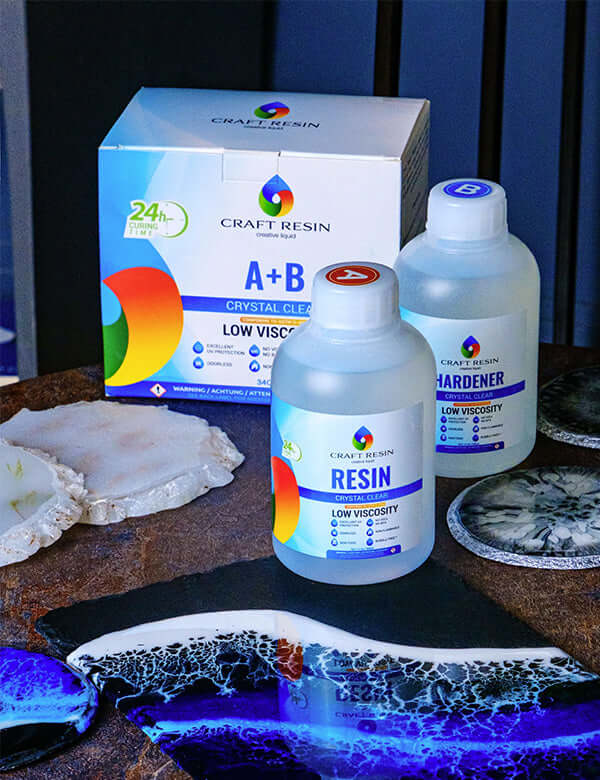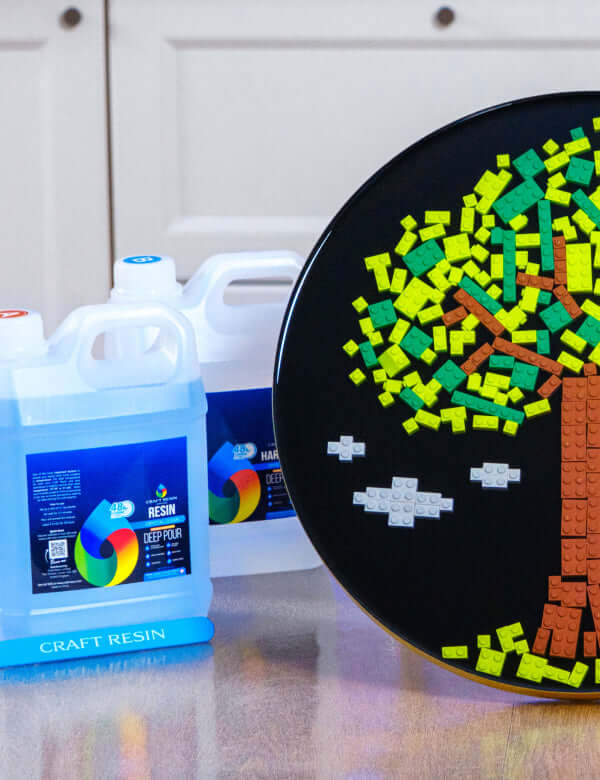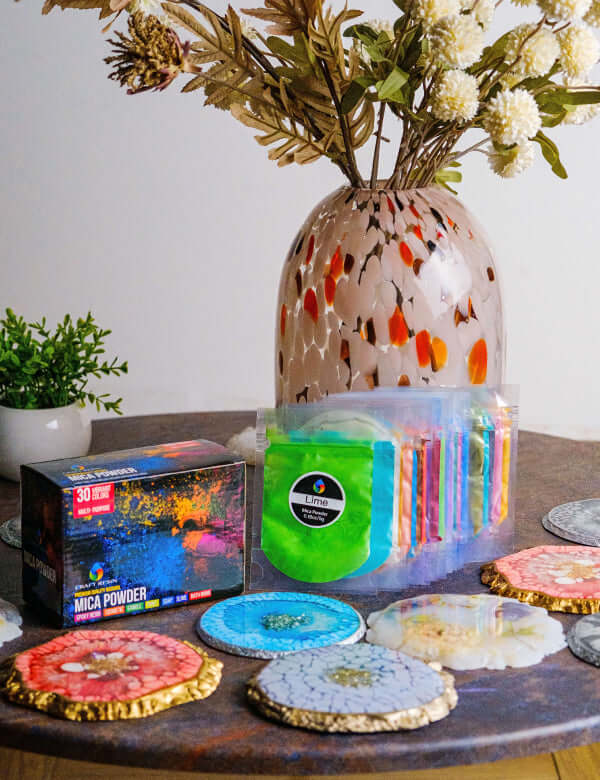We decided to explore the fascinating world of molds in today's blog post. Since epoxy resin is a liquid and ours is a low-viscosity resin, therefore highly runny, you may need to cast your creations in a mold to preserve their form while working with it.
It's only sometimes necessary to use a mold when working with Craft Resin to cover artwork, fill in gaps in wood, etc. However, a mold is almost always necessary when working with resin for projects like coasters, jewelery, and cake stands.

The following topics will be discussed in this blog:
- What kinds of things may be used as molds, and How do you construct your molds
- Where these molds can be obtained
- How to properly prepare molds;
- How to properly clean them;
- Where to put them away
Molds may be found in various styles, sizes, forms, and materials. Which one you choose to employ will be determined to a large extent by the project you want to build.
What kinds of things may be used as molds and How to construct your molds:
Utilizing sellotape or brown tape is the most fundamental choice available to you when it comes to making your mold. On top of non-porous boards, they may be used to draw the contour of a shape, producing a dammed area into which crystal clear epoxy hardener and resin can be poured. The shape can then be utilized to make a mold. Make sure that the adhesive side of the tape is not on the side that the resin will be poured into; you may fold the tape over to prevent this from happening. Pour the resin into the gap where the glossy side is since it won't cling to the resin in that case.
After the item has been allowed to cure completely, you will be able to remove the board and tape from beneath it. When it comes to this, the most important thing to watch out for is ensuring that your tape is sealed so that it does not leave any gaps behind; you may want to stack it up to ensure this happens.
One disadvantage of utilizing tape is that it may be quite challenging to form it into the precise shape that you want. Because of this, further sanding will likely be required after the item has been cured to get the desired appearance.

If you're in the jewelry-making business, you can get your hands on things like open-back bezels, and if you're in the business of making anything else, you can get your hands on closed-back bezels. These will be a permanent component of the jewelry you're making, so they might lend a touch of class to the overall look you're going for. Resin, coupled with a rainbow of colors and patterns, may turn them into beautiful necklace pendants.

Since silicone is flexible and resistant to resin adhesion, it is one of the best materials for manufacturing molds. Therefore, once the resin has cured fully in the mold, it may be easily removed. If you want to make your silicone molds, there are a multitude of videos on YouTube that will show you how. You may also get a broad selection of silicone molds at internet stores, and since they can be used several times, the costs are reasonable.
Coasters, pyramids, and even sculptures of the feminine form may be cast using silicone molds, which can also be used to cast just about anything else you can imagine. The silicone molds that may be purchased come in an extremely wide variety of forms and designs.

When it comes time to take your finished product from the mold, investing in a release agent is worthwhile. This will make the work less adhere to the mold and simpler to remove. This is particularly helpful for bigger tasks and reduces the risk of injuring your work or mold. You can once again get them from Amazon; search for "mold release spray for resin," and several options will come up for you to choose from.
Where these molds can be obtained:
Because molds are such an important aspect of working with resin, we've included some resources for locating them, even though Craft Resin doesn't sell them.
Many small firms produce molds of all sizes and shapes, and some may even tailor their services to your specific requirements. When consumers have a positive experience with a local company, they often suggest it to others in our Facebook group.
Molds are also available for purchase on websites like Amazon, eBay, and Etsy. Anyone who has produced anything you like will likely tell you where they acquired the mold and may even provide a discount link so you can buy it at a lower price.
If you want your products to have a glossy finish, check purchasing molds online since some of them are matte molds and cannot give you a shine. When using common molds with Craft Resin, you'll get a fantastic glossy finish without any extra work.
Caring for your molds:
While molds do not have an infinite lifespan, you can keep them in excellent condition for a considerable amount of time by following the advice below.
If you've seen a shift in the quality of your resin work over time but haven't altered your processes or switched resin manufacturers, you should take a closer look at your molds. You can detect when a mold is no longer usable by looking at your resin work.
Although this blog will focus on silicone molds, many of the suggestions also apply to other types of molds.
How to properly prepare molds;
Before using their molds, some people cleanse them with an alcohol mist or spray to prevent bubbles from developing on the side of the project facing the mold. If your finished product has bubbles below it while it is still in the mold, you may use a heat gun to remove them from the top of the product, but you cannot remove them from the bottom.
If you are going to be working with Craft Resin, you won't need to do this step. This is because the simple act of warming your resin will, in most cases, help bubbles disperse. If you want to use an alcohol mist or spray on your molds, you should first ensure that there is sufficient air in the room and then put on a mask or a respirator before beginning the process.
Alcohol mist or spray has the potential to catch fire; thus, you should exercise great caution if you want to use a flame anywhere near your molds after applying it.
If you can get around beginning with this step, we strongly suggest you do so so that you may see how things go without it.
Silicon release spray that you can use to prepare molds before casting resin. When a light coating has been sprayed, and the molds have been set for approximately a minute, the resin can be poured in. Once the resin has cured, you may easily remove it from the mold and use it for anything else.
How to properly clean them;
Some resin will likely seep into the spaces surrounding your molds as you pour it, but this is not reason for alarm; silicone molds, in particular, make it easy to remove any excess material when the curing process is complete.
As soon as you finish working with epoxy resin dye and take your object from the mold, you should clean it. Removal of the first resin from the molds may be possible by gentle peeling with your hands or cleaning off with something mild like baby wipes.
If any remaining resin fragments are difficult to remove, try soaking the mold in hot water (not boiling) long enough to transform the resin into a liquid.
Another method that achieves the same result without destroying the mold is to place it in the freezer for ten to fifteen minutes.
You should avoid alcohol while cleaning mold since it might harm the mold and speed up its degradation. It may also make your mold dull, which will prevent your resin products from shining as brightly. There's no way to stop this from occurring, so if you see it, your only option is to get a new mold.
Warm, soapy water, such as that is made with regular dishwashing solutions, is required to clean molds. To clean the molds, fill a dish with soapy warm water and let the molds in there for a few minutes (around 15).
After letting the molds soak for a bit, you may use a soft sponge to remove the resin from the molds. If your sponge has a coarse side, avoid using it on the molds so as not to scratch or chip them.
After using soap bubbles to clean the molds, rinse them well and set them aside on a clean towel to dry naturally. If you dry them with a cloth, the fibers from the fabric might end up in your next resin creation. You may cover them with a kitchen roll to prevent further contamination.

Where to put them away
Once your molds are dry, you may decide where and how to save them for future usage. We like to spritz them with silicone release spray and then set them aside to dry again. This little action will go a long way towards preserving your molds and extending their useful life.
The next step is to get a bag to keep your molds in, such as a sandwich or ziplock bag. You can place dry molds into these one at a time, with as much air squeezed out as possible before closing.
It's important to keep the molds in a flat, undamaged state while not in use. If left in a deformed state, they may take on that form permanently. Stacking them on a shelf will keep them for a long time.

Our goal is to lessen the frequency with which you have to buy new molds as you progress in working with resin.
We'd love to hear from you if you have any more advice you'd want to contribute on this topic in the comments section below this blog post.
Topic Of The Week Giveaway:
We have attached a giveaway to this Topic Of The Week announcement on our Instagram platform; this is helping us to spread the knowledge of how to use epoxy resin further, but also enabling anyone who helps us to share this information to win free resin and mica powders.

To enter the weekly giveaway, please see the latest post #CRWEEK44 on our Instagram feed/highlights and follow the instructions to enter:
We hope you get lots of use out of your molds and you get to create from them for many years to come.
Team Craft Resin






